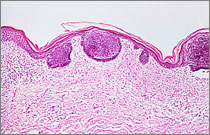Cervical cancer
| 2022 | |
|---|---|
¹ per 100,000 persons, age-standardised according to the old European standard population * until 1.12.2020 ** calculated using the period method for 2019 / 2020 | |
| Women | |
| Incidence | 4,388 |
| Age-standardised incidence rate¹ | 8.7 |
| Deaths 2023 | 1,413 |
| Age-standardised mortality rate¹ | 2.4 |
| 5-year prevalence* | 17,400 |
| 10-year prevalence* | 31,400 |
| Relative 5-year survival rate** | 64 % |
| Relative 10-year survival rate** | 60 % |
In Germany, approximately 4,640 women were diagnosed with invasive cervical cancer in 2022. It is important to distinguish here between a localised tumour that has not yet invaded the surrounding tissue (in situ carcinoma) and a fully developed cancer from which metastases can develop (invasive cancer). In about seven out of ten cases of invasive cervical cancer, the tumour originates from the squamous epithelial tissue of the cervical mucosa. Adenocarcinomas, in contrast, tend to originate in the higher-lying transition between the uterine body and cervix.
The incidence rates for invasive cervical cancer in women have been largely stable over the last 15 years, after a very sharp decline in the preceding three decades. Approximately four out of ten diagnoses occur at an early tumour stage (stage I).
 Age-standardised incidence and mortality rates, ICD-10 C53, Germany 1999 – 2018/2019, projection (incidence) through 2022, per 100,000 (old European standard population)
Age-standardised incidence and mortality rates, ICD-10 C53, Germany 1999 – 2018/2019, projection (incidence) through 2022, per 100,000 (old European standard population)
The average age at diagnosis of invasive carcinoma is 53 years.
In total, approximately 1,600 women in Germany currently die of cervical cancer every year; 30 years ago, the number was more than twice as high. The relative 5-year survival rate after diagnosis of an invasive cervical tumour is 64 percent.
Internationally, new cases and mortality rates in countries with long-standing, well-organized screening programs are substantially lower than in countries without such programs.
Viruses increase risk of cancer
The main cause of cervical cancer is a persistent infection with sexually transmitted human papillomaviruses (HPV). An asymptomatic HPV infection is common and usually resolves without consequences. Persistent infection with high-risk viruses such as HPV 16 and 18 can lead to the development of cervical cancer. Additional risk factors are smoking, other sexually transmitted pathogens (e.g. herpes simplex, chlamydia), early onset of sexual activity, a large number of births and a severely weakened immune system. The long-term use of oral contraceptives (birth control pills) also slightly increases the risk of the disease. Certain hereditary factors may promote the development of cervical cancer.
What early detection and prevention measures are available?
The statutory cancer screening program provides for an annual cervical smear test (PAP smear) and cytological examination for women aged 20 and over. From the age of 35, an HPV test combined with the PAP smear has been offered every three years instead since the beginning of 2020. The Standing Committee on Vaccination (STIKO) recommends vaccinating girls and boys against HPV, primarily between the ages of 9 and 14. Up to the age of 17, statutory health insurance companies will cover the costs of a catch-up vaccination. It does not replace early detection, as it does not protect against all high-risk HPV viruses.
Date: 30.12.2024






